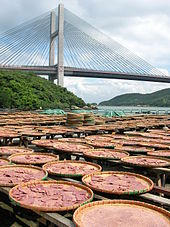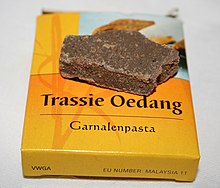Shrimp paste

Shrimp paste is a seasoning paste that is commonly used in Asian cuisine and consists of fermented shrimp . The shrimp paste is known by different names in the different Asian countries where it is used.
Manufacturing


There are different ways to prepare the shrimp paste. In China and many Southeast Asian countries , the fresh prawns are first heavily salted and dried in the sun for a few days until they turn into a thick, dark pulp. This fermentation process is usually repeated a few times until the paste is fully mature. The paste is then dried and cut into blocks for sale.
In Malaysia , for the production of belachan, fresh small shrimp of the “Gerago” species are first pounded into a paste and then buried in the ground for several months. After fermentation, the shrimp paste is dug up again, fried and pressed into cake.
The finished paste consists of about 85% shrimp and 15% salt.
use
The shrimp paste has an extremely spicy taste and smell, which - if you are not familiar with the spice - can even be perceived as repulsive. In Vietnam, Thailand , Malaysia, Indonesia and the Philippines , however, shrimp paste is an essential ingredient in many dishes, for example in curries or in sauces ( sambals ) that are served as a dip with fish and vegetables . The shrimp paste is very well known as a component of sambal belachan , a spicy sauce made from roasted belachan, chopped chili peppers , chopped garlic , a little shallot paste and sugar . The shrimp paste can also be eaten pure with rice .
